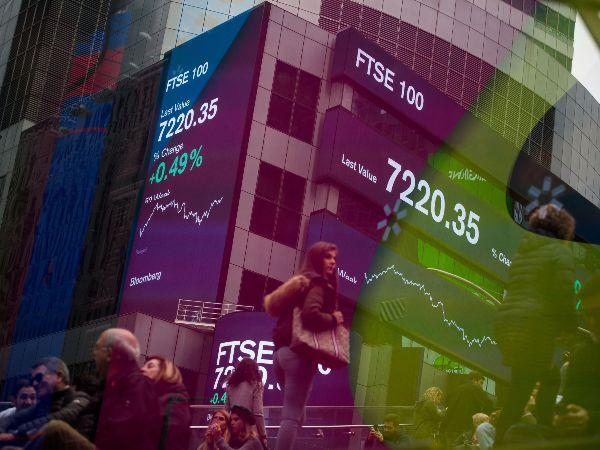FTSE 100: is the only way down?
The FTSE 100 fell by 2% yesterday to 7,019 points. Uncosted tax cuts, rate rises, and a worsening recession could make the hoped-for recovery implausible.
 Source: Bloomberg
Source: Bloomberg
PM Truss and Chancellor Kwarteng’s ‘fiscal statement’ has stark implications for the FTSE 100.
Dubbed the ‘mini-budget’ by the press, it avoided the Office of Budgetary Responsibly requirement to publish economic forecasts concurrently. This decision was denounced as ‘not the best start’ by IFS Director Paul Johnson, with Commons Treasury Committee Chair Mel Stride warning the forecast was ‘vital.’
And the markets have reacted accordingly.
FTSE 100: mini budget
This non-budget is by far the largest single change to government finances since the 1970s.
Stamp duty cuts, a reduction in the basic tax rate, scrapping the additional 45% rate, reversing the NI and dividend tax hikes, cancelling the planned 2023 corporation tax hike, new investment zones, and scrapping the ban on bankers’ bonuses all made an appearance.
But the IFS response was immediate, and scathing:
‘The biggest package of tax cuts in 50 years without even a semblance of an effort to make the public finance numbers add up. Instead, the plan seems to be to borrow large sums at increasingly expensive rates, put government debt on an unsustainable rising path, and hope that we get better growth.’
The think tank warns that the Energy Price Guarantee will cost £60 billion over the next two months alone. And by FY26-27, borrowing will be over £110 billion, or 3.9% of GDP, more than £80 billion higher than the OBR’s £32 billion forecast earlier this year.
The government contests that its radical plan could increase annual UK economic growth to 2.5%, a rate not seen in the past decade.
But as the IFS warns, ‘Mr Kwarteng is not just gambling on a new strategy; he is betting the house.’
 Source: Bloomberg
Source: Bloomberg
FTSE 100: where next?
Friday’s market response was immediate. Forgetting politics, markets crave certainty. And the UK’s economic outlook was already far from certain.
Of course, certain FTSE 100 stocks — housebuilders like Persimmon or banks like Lloyds — could stand to benefit from stamp duty cuts and interest rate rises. However, the FTSE 100, as the wider benchmark of the UK economy, could be in trouble.
Its outperformance over the S&P 500 in 2022 has been predominantly due to the record profits of oil majors BP and Shell, and miners like Rio Tinto. But these are cyclical stocks, and the tide always turns eventually.
The key issue is what the UK looks like to outside investment. Friday saw the FTSE 100 briefly fall below the symbolic 7,000-point watermark, before recovering to end the day down 2%, or 141 points, to 7,019.
Five-year gilt yields rose by 50 basis points to a 14-year high of 4.06%; their biggest daily increase since 1991. Meanwhile, ten-year gilt yields rose to 3.83%, their highest since April 2011.
Sterling sold off to as low as $1.08, before recovering to $1.09. For perspective, £1 bought $1.18 only a month ago, and $1.37 last year. Some analysts are forecasting pound-dollar (GBP/USD) parity within the next 12 months.
Yet more uncertainty is found in the diverging economic positions of the new government and the Bank of England’s Monetary Policy Committee.
The Bank, which gained political independence in 1997, is set on a path of tightening monetary policy to control inflation. Conversely, the new governing administration is set on loosening fiscal policy, to promote growth.
This means the two institutions in charge of the UK economy are diametrically opposed. As former US Treasury Secretary Larry Summers argues, ‘the UK is behaving a bit like an emerging market turning itself into a submerging market...Britain will be remembered for having pursued the worst macroeconomic policies of any major country in a long time.’
Worse still, MPC members are divided.
While agreeing that the fiscal event could affect the economic outlook in a ‘material’ way, five members voted for and won, a 50 basis points base rate rise to 2.25%. But three voted for 75 basis points, to match its transatlantic counterpart, and one for just 25 basis points.
And the Bank has warned the UK is already in a recession that could last to year-end 2023. There may be no good options.
While CPI inflation is now expected to rise to only 11% as a result of the energy intervention, analysts expect the bank rate to exceed 5% by mid-2023, partly to offset inflation, but also to compete against the safe haven of the US dollar.
Deutsch Bank analyst George Saravelos argues that ‘a large, inter-meeting rate hike from the Bank of England as soon as next week to regain credibility with the market’ is warranted.
He also notes that reversing the planned sale of UK government bonds would only worsen the situation. The Bank has committed to selling £8.7 billion of its £838 billion government bonds pile in Q4, with a further £72 billion to be sold over the next year.
This quantitative tightening will occur at the same time as the government sells bonds to borrow for tax cuts.
And of course, as monetary policy tightens, mortgage and debt defaults rise, while investment in growth falls. This could render the mini-budget entirely ineffective.
The Chancellor’s high-risk strategy could entail a larger FTSE 100 correction before the year is out.
Trade and invest in over 17,000 UK, US and global shares from zero commission with us, the UK’s No.1 trading provider.*
Learn more about trading or investing in shares with us, or open an account to get started today.







0 Comments
Recommended Comments
There are no comments to display.
Create an account or sign in to comment
You need to be a member in order to leave a comment
Create an account
Sign up for a new account in our community. It's easy!
Register a new accountSign in
Already have an account? Sign in here.
Sign In Now